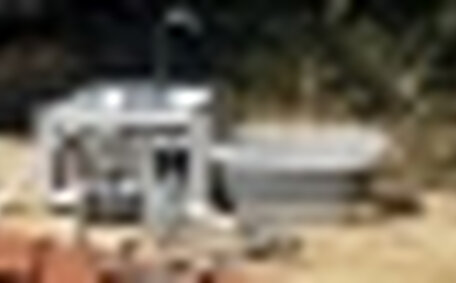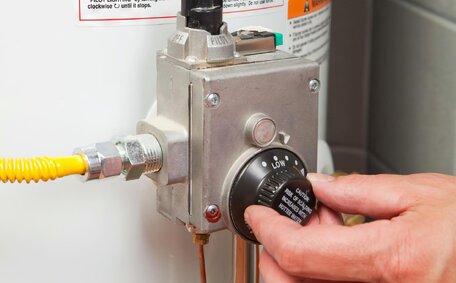Understanding your gas supply system
Homes and businesses typically utilise one of two main gas supply systems: natural gas or LPG (liquefied petroleum gas). Correctly identifying and shutting off your system is vital.
Natural gas
Natural gas travels through underground pipes from the utility company to your location. The key components of a natural gas system include:
- The gas meter – This device records your gas consumption.
- The service line - The underground pipe that connects your property to the utility’s gas distribution line.
- The gas supply line - A pipeline that directs gas from the meter into your property.
- The appliance shut off valves - Enable you to individually interrupt gas flow to appliances.
- The emergency gas shutoff valve - Allows you to cut the entire gas supply to your property in case of an emergency.
LPG systems
LPG systems use refillable tanks located on your property to store the gas. The key components are:
- The LPG storage tank – Houses the gas on-site
- The service valves on the tank
- The gas supply line running into your home/business
- The appliance shutoff valves
Understanding precisely when you need turn off your gas supply to ensure your hot water system and other appliances are safe is critical whether you use natural gas or LPG.
Locating the gas meter
Natural gas meter gas regulators are often located in a meter box by the side your property, such as under stairs or near the kitchen. However, the exact location can vary and it’s where you’d turn the gas supply off.
Understanding your property layout to locate the gas meter is important for homeowners. Common placement areas are:
- Under the stairs
- Next to the kitchen or external wall
- Inside the garage
The gas supply line functions akin to a water pipe, extending from your meter to the street-level main distribution line and is impacted when managing gas flow.
If you have an LPG system, the gas cylinder and service valves that constitute the gas supply can impact your water system, and are often found in your yard. The gas supply line runs from the tank into appliances your home relies on, including your hot water system.
Take time to inspect your property and identify all gas supply components, such as your water heater and gas shutoff valve. Knowing your system’s layout is essential for emergency preparedness.
Identifying the gas shutoff valve
Being aware of the location of your main gas shutoff valves is critical for the safe management of your property’s gas supply, particularly in emergencies or if gas leaks occur.
The gas shutoff valve usually sits in proximity to the gas metre, either on the ground or wall-mounted in a metre box. It may be labelled with a small tag saying "Gas Shutoff Valve". With an LPG system, the shutoff valve, typically found on the top cylinder, will be externally located by your home close to the gas tank.
Rotating the main shutoff valve clockwise to the 'off’ position will halt the gas supply to your home, temporarily deactivating appliances like your hot water system, stove, and heater until reconnection.
In an emergency, find the main shutoff valve near the meter and turn it clockwise to 'off’. Afterwards, consult your gas company or a licensed gas fitter to safely restore gas supply.
Ensure you know where your shutoff valve is and it remains unobstructed for rapid access when necessary.
Safety precautions before turning off gas
It’s a good idea to take safety precautions where the valve is usually located before turning off the gas supply:
- Make sure to turn off all gas appliances and their pilot lights first to avoid any risk when the gas supply is cut.
- Keep an ABC fire extinguisher within reach for potential use.
- Open all doors and windows to ventilate the area more than usual in case of any gas leaks.
- Avoid manipulating electrical switches and extinguish all potential ignition sources if you suspect a gas leak.
- Do not use lighters, matches or anything that can spark a flame.
- Clear the area of all people and pets before turning off the gas.
If you detect a gas odour, evacuate immediately and call emergency services from a safe distance. Do not re-enter until it is confirmed safe.
When a professional gas technician certifies it’s safe, you can reactivate your gas to relight your hot water system and pilot lights.
Step-by-step instructions for turning off gas
Adhere to the following steps to safely discontinue your gas supply:
- Locate your gas meter, typically near the front of your property.
- Unlatch the gas metre box to close gas supply valve within.
- Locate the turn tap for the gas supply valve inside and ensure you can access it.
- Use an adjustable wrench to gently turn the valve tap 1⁄4 turn clockwise to the horizontal off position.
- The valve is now closed and your gas supply is turned off.
LPG supply
- Locate your LPG gas tank outside your property.
- Close all valves on the tank by turning them clockwise.
- Twist the valve on top cylinder clockwise until snug to ensure the gas supply is shut off securely.
If you ever smell gas, immediately evacuate and contact the emergency gas service. Do not resume the gas supply until a licensed technician inspects for leaks and verifies safety.
Handling LPG cylinder shutoff
When handling the shutdown of an LPG cylinder, it is critical to ensure the main cylinder valve is fully closed to cut off the gas supply.
Follow these safety checks when turning off an LPG cylinder:
- Check the cylinder gauge to see if there is gas remaining before attempting to turn off the valve.
- Clear all combustible materials away from the cylinder.
- Use protective gloves when handling the main cylinder valve.
- Locate the main cylinder valve on top of the tank.
- Use both hands to grip the valve tightly and slowly turn it clockwise until it is fully closed and will not turn any further.
- Listen and check for any hissing sounds indicating gas escaping after closing the valve.
- Store upright, secured in place and with the valve closed.
If you ever detect a scent suggestive of a gas line breach, evacuate immediately and call your gas supplier from a secure location. Never attempt to relight an appliance yourself after gas interruption - always call a licenced professional.
Relighting appliances after shutting off gas
After the gas supply is shut off and restored, ensure it is safe to resume usage and relight appliances per the manufacturer’s instructions.
If unsure about using appliances after shutdown, contact a licenced gas fitter to handle the task safely.
General guidelines for relighting appliances:
- Make sure the gas supply is fully turned back on at the metre or LPG cylinder.
- Open the shutoff valve for each appliance you intend to relight.
- Refer to the user manual for how turn off specifics on relighting pilots and burners.
- If a pilot goes out, allow gas fumes to evacuate before relighting.
- Always attend to appliances when relighting pilot lights.
- If any smell of gas persists, turn off the appliance and gas supply and call your gas supplier immediately.
Relighting gas appliances after any interruption, including when you turn off water or gas supply, can be hazardous if unsure. Always exercise caution or call a professional if needed.
Gas safety during bushfires
In the presence of gas appliances and supply lines, bushfires are a serious hazard. Preparation and knowing how to respond in a bushfire emergency are crucial for mitigating gas-related risks.
Before the fire approaches
- Have an evacuation plan ready and prepare your property as much as possible, clearing any flammable items.
- Ensure you know when you should turn off the gas supply pipe to your home or business.
- Maintain LPG cylinders, ensuring they’re upright, tightly connected, and clear of debris.
As the fire front approaches
- Shut off the gas supply at the metre or LPG cylinders.
- Turn off appliances at their individual shutoff valves.
- If time permits before evacuating, secure LPG cylinders by relocating them a safe distance away from structures if possible.
If LPG cylinder shutdown is not accessible, evacuate without delay as the firefront nears, prioritising safety above all.
After the danger has passed
- Do not attempt to turn gas back on until supply lines and appliances have been inspected by a licenced professional.
- The LPG cylinder’s valve, usually the main point to check, must be inspected for damage before reconnecting.
- Contact your gas entity for guidance if your system sustained any fire impact.
Preparation for bushfires both before and during emergencies is essential to mitigate risks associated with gas supplies.
Assessing your gas system after an emergency
After any emergency situation involving your gas system, such as a fire, flood or earthquake, it is crucial that you do not turn the gas back on until the system has been thoroughly assessed and cleared by a licenced gas fitter.
A qualified technician will check the following including where each valve is located:
- The gas metre and gas pipes for any damage
- The integrity of seals on gas pipes and connections
- All appliances and pilots to ensure they are intact and functional
- Pressure tests to check for leaks throughout the system
Technicians will repair or replace damaged components, re-establish connections, and relight appliances to safely restore your gas system to operation.
If you ever smell gas following an emergency, evacuate immediately and call your gas emergency service. Never assume it is safe to turn gas back on or relight pilots after any incident - always rely on professionals to check system integrity first.
Once your system receives the all-clear from a registered gas technician, rest assured that your gas supply is reliably secure and ready for continued use.
Maintaining ongoing gas safety
Complying with energy department standards for gas system maintenance is essential. Periodic reviews by qualified technicians are vital for early leak or fault detection. Inspections include gas lines, connections, appliances, and meter integrity.
We recommend annual gas safety inspections as detailed on our website. Our licensed Riverwood Plumbing technicians provide these services, ensuring your system meets Australian Standards and conducting necessary repairs.
Service your gas appliances regularly in line with manufacturer maintenance schedules to prevent faults or leaks, with specifics available on our website.
Discover more about gas safety concerns, repairs or installation work by contacting our friendly team on 1300 349 338. You can also email us at [email protected] or use our online contact form to arrange an appointment.
Over 25 years of expertise in the Riverwood area equip us to address all plumbing and gas-related requirements.






